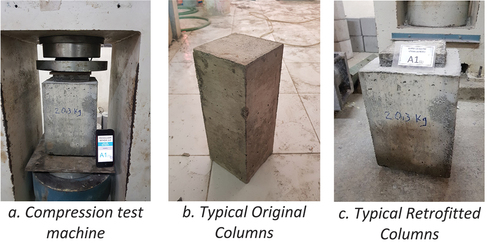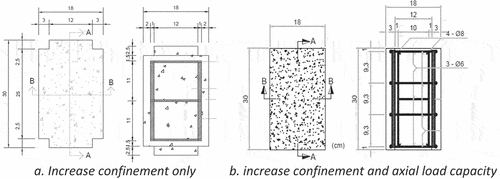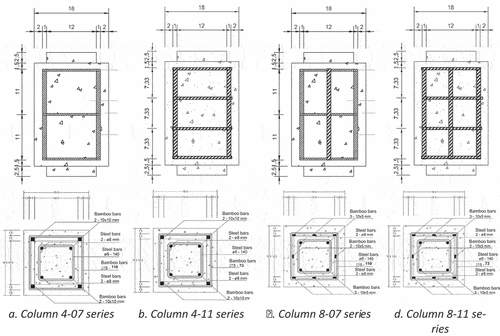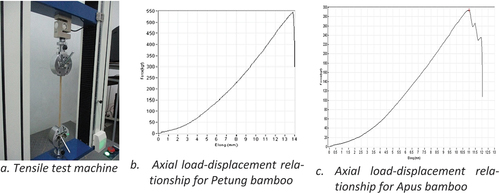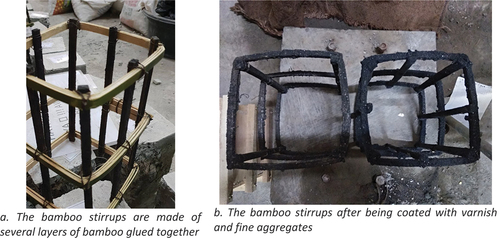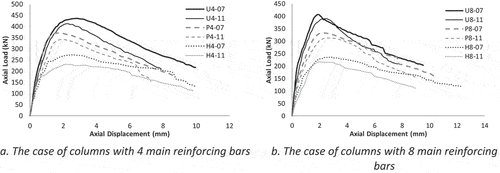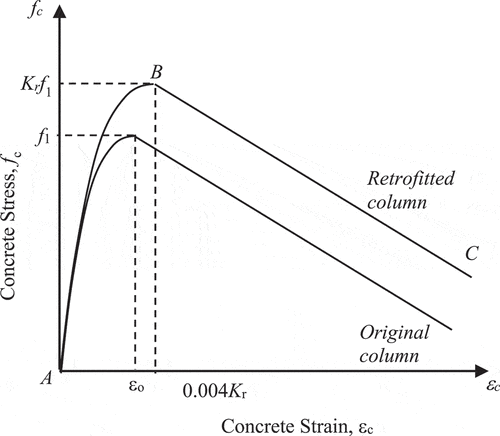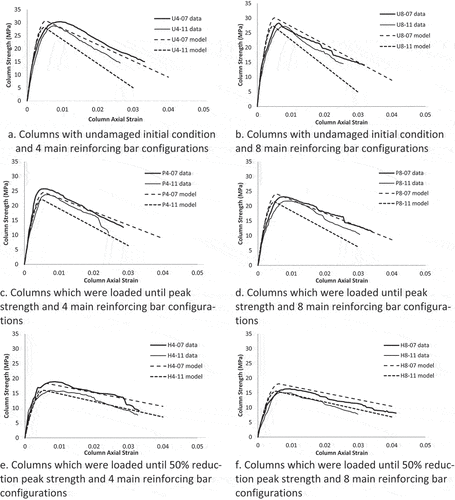 ?Mathematical formulae have been encoded as MathML and are displayed in this HTML version using MathJax in order to improve their display. Uncheck the box to turn MathJax off. This feature requires Javascript. Click on a formula to zoom.
?Mathematical formulae have been encoded as MathML and are displayed in this HTML version using MathJax in order to improve their display. Uncheck the box to turn MathJax off. This feature requires Javascript. Click on a formula to zoom.ABSTRACT
The need for retrofitting of building structures is generally caused by two cases: to repair damaged structures or to improve the structural performance of weak structures. The concrete jacket method is widely chosen to solve the problem due to the more economical and simple procedure compared to other methods. In this study, retrofitting using bamboo-reinforced concrete jacket (BRCJ) was applied on reinforced concrete columns. Bamboo was used to replace steel as the longitudinal and transverse reinforcements of the concrete jacket with the aim of finding an alternative for an environmentally friendly green material and a lower-cost manufacturing process compared to steel. The performance of the jacket was studied by investigating the confinement effectiveness that is influenced by initial column conditions, spacing of bamboo stirrups, and the slenderness of longitudinal reinforcement. The outcomes showed that the bamboo-reinforced concrete jackets were able to strengthen the columns up to 170% and 140% of the initial strength of the undamaged and damaged columns, respectively. The BRCJ is more effective on columns that are still at the pre-peak-strength stage. The confinement effectiveness is also largely affected by the bamboo stirrups spacing. By reducing the spacing of bamboo stirrups to about half that of steel stirrups, the ductility ratio of retrofitted columns increased up to 90% higher than the original columns. Further, the confinement effect of BRCJ can also be increased by increasing the slenderness ratio of bamboo longitudinal reinforcement. Finally, the stress–strain relationship for concrete columns retrofitted with bamboo-reinforced concrete jackets has been proposed which shows great agreement with the experimental data. Overall, BRCJ has shown promising results to be used to strengthen damaged or weak structures.
1. Introduction
The purpose of retrofitting structures can generally be categorized into two cases, namely to repair damaged buildings, or to improve the performance of weak structures. In the first case, failure can occur to the structure due to overload with damages, such as cracks, crushed concrete, and bent steel bars. Whereas in the second case, weak structures are structural elements that lack the strength to withstand even the service load even though there is no visible damage. Weak structures are commonly caused by poor design, poor materials used, or improper construction methods. On the other hand, an increase in structural performance is also needed if there is a change in building function which results in an increase in loads (such as from an ordinary office function to a warehouse where the ultimate floor loads increase quite significantly). Some retrofitting methods such as FRP are more suitable for weak elements, whilst jacketing techniques are more versatile for both damaged and weak structures.
The common jacket technique is RC jackets. Many studies have comprehensively investigated the application of concrete jackets to RC columns [Vandoros and Dritsos (Citation2008), Bousias et al. (Citation2007), Thermoua et al. (Citation2014), Minafò et al. (Minafò, Trapani, and Amato Citation2016), Navarrete et al. (Citation2016), Lampropoulos et al. (Citation2012), Júlio, Branco, and Silva (Citation2005, Citation2008)] which as a whole suggested that the concrete jacket method was effective in strengthening the weak or damaged columns. Ersoy and Tankut (Citation1993) tested two groups of columns with different loading combination types and histories (axial and reverse lateral load). It was proved that in all schemes, the retrofitted columns showed increased performances. Bett et al. (Citation1988) investigated the effect of the concrete jacket on strengthening three columns with a jacketed and unjacketed variation resulting in increased lateral strength and stiffness of the columns. Eduardo et al. (Citation2005) focused on the surface treatment of undamaged columns for concrete jacket applications. This showed that for short columns, the monolithic mechanism can be maintained even without any surface treatment. Meanwhile, Rodriguez and Park (Citation1994) studied the effect of the initial condition of columns and the stirrups arrangement of the concrete jacket on columns subjected to seismic load. Interestingly, it turned out that both the initial condition and the two applied reinforcement arrangements had little effect on the seismic performance of the columns. However, the application of a concrete jacket could still improve the performance of weak concrete columns. Dubey and Kumar (Citation2016) are interested in observing the axial performance of cylindrical RC columns jacketed using various types of self-compacting concrete (SCC) and curing time. In general, it was found that the SCC jacket performed reasonably well in increasing the peak strength capacity of the retrofitted columns.
In accordance with the awareness of sustainable development, the use of alternative materials is an important issue today. Bamboo is a structural material that has been studied as a substitute for steel as reinforcement in concrete. Besides being relatively cheaper, bamboo is also very common in developing countries such as in Asia. In this study, the use of bamboo as reinforcement in the concrete jacket is investigated. Many studies have been conducted to investigate the possibility to use bamboo as reinforcing steel in regular concrete structures. Sharma et al. (Citation2015) compared the engineered bamboo products in the form of bamboo scribers and laminated bamboo with timber. It was found that the bamboo scriber in general had better compressive and tensile strengths, but lower shear strength compared to laminated bamboo. Interestingly, the properties of both products were comparable to those of timber. Xu et al. (Citation2014) investigated the performance of bare bamboo when immersed in water. Reasonably, the increase of moisture content (MC) decreases the compressive strength down to 75% for one-day immersion of bamboo in the water (MC = 12%). Nevertheless, Javadiana et al. (Citation2016) studied the effect of various epoxy resin coatings on bamboo to increase bond strength. The outcomes showed that the combination of water-based epoxy resin and sand provided reasonable bond strength and long-term resistance to water and alkaline reaction in the concrete. Furthermore, the bond strength of bamboo bars with concrete had been investigated by Agarwal et al. (Citation2014) as well as using chemical adhesive treatment. It was observed that by using the Sikadur gel, the bond strength of treated bamboo bars increased by about 4 times higher than that of the plain bamboo bars. Moreover, the application of bamboo as steel replacement in structural elements has been conducted by Moroz et al. (Citation2014). It was proved that bamboo reinforcement showed similar performance when compared with steel reinforcement. Wibowo, Wijatmiko, and Nainggolan (Citation2017a, Citation2017b) investigated lightweight bamboo-reinforced slabs with Styrofoam panels as fillers. The results showed that although the flexural capacities of bamboo-reinforced concrete slabs were about 15% smaller than those of normal concrete slabs, they had total weights that were average 20% smaller. In terms of the design or practical point of view, it is considered acceptable because usually, the required nominal flexural capacity of the slab is less than the flexural capacity of the minimum reinforcement ratio suggested by the code.
In general, previous studies have shown that bamboo can be considered an alternative to steel reinforcement. However, to the knowledge of the authors, no studies have investigated the application of bamboo in concrete jacket applications, therefore the research presented in this paper is original and novel. The aim of this paper is to discuss the application of bamboo-reinforced concrete jackets (BRCJ) on columns subjected to axial load.
2. Materials and methods
Generally, the axial behavior of RC columns in terms of strength and ductility is affected by the confinement effectiveness and material properties (Park and Paulay Citation1975; Wibowo et al. Citation2014). The effectiveness of confinement generally depends on the steel reinforcement configurations (longitudinal reinforcement ratio, transverse reinforcement ratio, bar slenderness, and steel bar spacing), whereas the concrete strength and yield strength of stirrups both provide the upper limit of confinement.
In this study, the columns were designed to investigate the effectiveness of bamboo-reinforced concrete jackets (abbreviated as BRCJ). Two stages of compression tests (refer to and ) were performed on 48 RC column specimens as follows:
First stage. All RC columns (refer to ) were divided into three groups where the compression tests were conducted to represent column conditions before retrofitting, i.e., 1) undamaged (no preload), 2) damaged due to initial load at peak strength condition, and 3) damaged due to initial load when the strength is reduced by 50% after reaching peak strength. It aims to represent the effect of BRCJ on various column initial damage conditions, the first case for weak elements, and the second and third cases for damaged elements. All the axial load–displacement relationships, peak strengths, and ductility values were recorded and analyzed.
Second stage. BRCJs were then applied to all columns (refer to ). The parameter variations on the BRCJ are as follows:
The spacing of bamboo transverse reinforcement to study the confinement effectiveness.
The configuration of the bamboo longitudinal reinforcement of concrete jackets to study the effect of bar slenderness.
Table 1. Configuration of BRCJ with the various initial conditions, longitudinal reinforcement, and transverse reinforcement.
The compression tests were then reconducted on all retrofitted columns. Again, the axial load–displacement relationships, peak strengths, and ductility values were recorded. The axial displacements were measured using LVDTs mounted at the compression machine.
2.1. Original columns
All column specimens were cast with a dimension of 12 × 12 x 30 cm as shown in . The main steel bars used were 4ϕ8 mm, whereas ϕ6 mm steel stirrups spaced at 140 mm were used for confinement (refer to ). The average concrete strength was 15 MPa, and the yield strength for main bars and stirrups were 370 MPa and 240 MPa respectively. In all cases, the concrete cover was 20 mm.
2.2. Retrofitted columns
After undergoing the first compression test using a different preload scheme as described in , the columns were then retrofitted using bamboo-reinforced concrete jackets. In this study, the retrofitting was designed so that the effects on peak strength and ductility were intentionally attributed to confinement effects only, not by adding up the total column cross-sectional area as shown in . An alternative with a full jacket as high as columns which provides an additional total area of concrete columns as described in has been studied and presented in previous studies (Wibowo, Wijatmiko, and Nainggolan Citation2019).
Two sets of bamboo longitudinal reinforcement, 4 bars 10 × 10 mm and 8 bars 10 × 5 mm, were used to study the effectiveness of confinement area for the same longitudinal reinforcement ratio of about 1.23% as presented in . In general, a more dispersed arrangement of reinforcement around the concrete core, instead of just placed at corners, increases the effective confinement area. However, the use of a smaller bar diameter results in more susceptibility to buckling and eventually limits the confinement effect. The main bar configurations used in this study were set to observe the combined effect of the two mechanisms. In all specimens, Petung bamboo (Dendrocalamus asper) with the ultimate tensile stress of 220 MPa was used for the longitudinal reinforcement (refer to ).
Furthermore, Apus bamboo (Gigantochloa apus) was used instead of Petung Bamboo for the transverse reinforcement because it was more flexible to bend to form 90° hooks. In all cases, bamboo stirrups with dimensions of 10 × 5 mm were used, which were considered equivalent to ϕ6 mm steel bars with a yield stress of 120 MPa. The varied spacings of the two stirrups were 70 mm and 110 mm as shown in (corresponding to volumetric transverse reinforcement ratios of 1.2% and 0.8% respectively).
The fabrication of stirrups needed careful attention since the bamboo bars easily cracked particularly at the corner of the hooks. Several treatments have been applied, such as normal bending, cutting-gluing, heating, and filling the cracks with epoxy; all with no successful improvement. The best technique was obtained by using a laminated bamboo periphery (outer) layer instead of a solid bar. The outer layers of bamboo were cut, bent, and then glued together to make laminated bamboo hooks as shown in .
The shortcoming of the bamboo application as reinforcement bars is the volume instability due to the characteristics of bamboo which expands and contracts due to the absorption and release of water during the setting and hardening stages of concrete. The treatment process for bamboo products is required to overcome this problem, where in this study and the previous study (Wibowo, Wijatmiko, and Nainggolan Citation2019), all bamboo bars were coated with varnish and rolled into fine aggregates to close the porosity and also produced rough surfaces to increase bond stress between bamboo bars and concrete. Some studies have tried different coatings (Agarwal et al. Agarwal, Nanda, and Maity Citation2014; Javadiana et al. Citation2016) which proved that proper coating can reduce the permeability of bamboo bars. Yet, the long-term volume stability of bamboo bars to water still needs further investigation in a practical context.
3. Results and discussion
From the test, it appears that the initial column condition affected the effectiveness of the BRCJ application. The retrofitting on U-series columns (undamaged without preload) could increase the axial load capacity up to about 1.8 times the original column capacity. Whilst, for the P-series columns where the initial load was stopped at the peak strength, the BRCJs were able to regain the peak strength up to 1.5 times the original column strength. However, the same configuration of BRCJ on the H-series column (with the initial load stopped at a 50% reduction after peak strength) could only recover the peak strength back to its previous capacity as presented in . Overall comparisons of the initial condition effects can be seen in which clearly shows the difference in strength increase.
As shown in , the use of bamboo stirrups with a spacing of 110 mm managed to maintain the ductility ratio of the retrofitted columns to the same as the original columns. Meanwhile, by adjusting the spacing of the stirrups to be closer to 70 mm, the ductility ratio of retrofitted columns increased by about 45% to 90%. A higher increase in ductility was found on H-series columns (columns with the most damage observed in the initial condition), whilst both P-series and U-series columns (columns with no damage or light damage in the initial condition) experienced a similar smaller ductility increase. It appears that even if the column conditions were quite severe, BRCJ was able to increase the ratio of ductility and peak strength capacity very effectively.
Table 2. Strength and deformation properties of all specimens.
Furthermore, the effect of the spacing of bamboo stirrups on the peak strength capacity can also be observed in and . By reducing the stirrup spacing from 110 mm to 70 mm, the peak strength capacities of the columns increased by about 5%, 7%, and 13% for U series, P series, and H series columns. Again, the effectiveness of the BRCJ increases with the initial damage level of the column.
In terms of the choice of stirrup spacing, it is advisable to use a closer spacing of bamboo stirrups in the concrete jackets than the spacing of steel ties in the original columns. This is due to the fact that the tensile strength of bamboo is lower than that of steel reinforcement providing a lower upper limit of confinement.
Despite having the same longitudinal reinforcement ratio, the use of 4 bars 10 × 10 mm configuration resulted in a higher increase of peak strength capacity of about 10% compared to those of columns with 8 bars 10 × 5 mm longitudinal reinforcement. In this study, it appears that the use of longitudinal reinforcement that is less in number but has a larger diameter provides greater stiffness than the reinforcement that is more spread around but slender. However, the change in bar configuration from 4 bars to 8 bars did not seem to significantly affect the ductility ratios of retrofitted columns. It can be deduced that the slenderness ratio of the longitudinal reinforcement had a considerable effect on the confinement effectiveness, particularly on the peak strength capacity.
Overall, the BRCJ showed good performance in improving the strength and ductility of the retrofitted RC columns with some considerations as follows:
The BRCJ is more effective when applied on columns that are still at the pre-peak strength stage.
By adjusting the spacing of the bamboo stirrups of the retrofitted columns to be about ¾ of the original columns’ stirrups spacing, the ductility ratio can be maintained relatively the same, since bamboo has lower tensile strength compared to steel. Further, by reducing the spacing of bamboo stirrups to about half of the spacing of steel stirrups, the ductility ratio of retrofitted columns increases from 45% to 90%.
The slenderness ratio on bamboo longitudinal reinforcement affects the peak strength of retrofitted columns. In this study, the use of 4 stiffer bars performed relatively better in terms of increasing the peak strength of retrofitted columns than 8 slender bars despite the same longitudinal reinforcement ratio used.
One thing to be considered, since this research is a pioneering study, it will require further research to gain a more thorough understanding of the effectiveness of bamboo applications in concrete jackets. Some parameters can be further investigated, i.e., variation of longitudinal reinforcement, concrete strength, and different types of bamboo.
Natural hazards should be paid close attention to for damaged or weak structures (Wang et al., Citation2022, Citation2023). The BRCJ system has shown promising results to be used to strengthen such structures. Therefore, the resilience of the BRCJ structure in terms of disaster prevention and mitigation measures needs to be studied in the future as well.
4. Stress–strain model
It is important to be able to predict the performance of the retrofitted columns compared to the original columns, in terms of stiffness, peak strength capacity, and ductility ratio. Therefore, the novel stress–strain relationship has been proposed in this study. The formula was developed (refer to ) based on the Modified Kent and Park (Kent and Park Citation1971; Park and Paulay Citation1975) using several findings from the test as follows:
The confinement effect on peak strength is affected by the slenderness ratio of longitudinal reinforcement, which can be calculated as the ratio of the longitudinal reinforcement cross-section area to the unsupported length of the longitudinal reinforcement between stirrups.
The effect of retrofitting on the existing specimens is clearly dependent on the initial conditions of the column. It was found that the higher the damage level of columns, the less effective the retrofitting application will be. This effect is counted in the formula using the parameter C applied to the peak strength of original columns (= Cfo).
The difficulty in actual practice is engineering judgment in determining the extent of column damage. Practically, forensic tests on structural elements can be performed to estimate the actual performance of the column.
Due to the lower stiffness and elastic modulus of bamboo compared to those of steel, the effect of BRCJ confinement occurs more slowly and at a later stage than that of steel confinement. It appeared in this study that the strain at peak strength occurred at about 0.004 instead of 0.002 as normally taken for normal reinforced concrete column cases.
The magnification factor can be calculated based on the effect of stirrups and the slenderness ratio of longitudinal reinforcement as follows.
Where:
= the transverse reinforcement ratio
f1 = the considered axial strength of the original column prior to retrofitting
fub = the tensile strength of the bamboo bar
shb = bamboo stirrups spacing
rh = radius of gyration of the bamboo main bar
I1b = moment of inertia of a single bamboo main bar cross-section
= the cross-section area of a single bamboo main bar
The column strength prior to retrofitting () is determined using the C factor on the peak strength of the original column (
). A note to be mentioned here, the calculation of the peak strength of original columns (
) uses the peak confined concrete strength
rather than common cylindrical concrete strength
, since the BRCJ is applied on reinforced concrete rather than unreinforced concrete. Many methods are available for calculating the peak confined concrete strength
such as Saatcioglu and Razvi (Citation1992), Popovics (Citation1973), Vallenas et al. (Citation1977), Binici (Citation2005), and Lokuge et al. (Citation2005); whereas, in this study, the formula suggested by Kent and Park (Citation1971) is used. Therefore, the procedures for calculating the column strength prior to retrofitting (
) is given as follows:
Where:
C = coefficient representing column condition prior to retrofitting.
= 1, for un-preloaded column.
= 0.75, for columns preloaded to peak strength capacity
= 0.5, for columns preloaded up to 50% reduction of peak strength capacity
fo = the axial peak strength of the original column
f’con = the confined concrete strength of the original column
Ac = area of concrete of original column
As = area of steel of original column
Ag = total area of original column = Ac + As
Overall, the procedure for estimating the stress–strain relationship for RC columns retrofitted with BRCJ is as follows:
a) Region AB (εc <0.004 Kr)
b) Region BC (εc >0.004Kr)
Where:
εc = concrete strain
fc = concrete stress confined with BRCJ
= ratio of bamboo stirrups cross-section area to the total area of the retrofitted column
= width of confined core measured to the outside of bamboo hoops
The comparisons of the stress–strain relationship between the experimental test results and the proposed model show good agreement as shown in . The tendency of the proposed model to be on the conservative side would be very helpful for practitioners and designers to have a larger measure of safety factor in designing the retrofitting.
5. Conclusions
Experimental tests have been conducted to investigate the effectiveness of bamboo-reinforced concrete jackets on groups of short RC columns. The parameters studied were the initial condition of columns, stirrups spacing, and the configuration of bamboo reinforcement. The initial conditions included undamaged (original), loaded to peak strength, and loaded to a 50% strength reduction after peak strength. This was aimed to observe the effectiveness of retrofitting on different column conditions. Further, to investigate the confinement effect, the bamboo stirrups in the concrete jacket are set to have a tighter spacing than the steel stirrups in the original column because the tensile strength of bamboo concrete is lower than that of steel. Therefore, the bamboo stirrups were taken at 70 mm and 110 mm compared to that of steel stirrups at 140 spacing. Finally, two sets of bamboo longitudinal bars with different configurations but with the same reinforcement ratio, i.e., 4 bars 10 × 10 mm and 8 bars 10 × 5 mm, were set to study the slenderness effect of bamboo longitudinal reinforcement.
The findings of the test showed that despite the lower tensile strength and modulus of elasticity of bamboo compared to those of the steel, the bamboo reinforced concrete jacket proved to be a good alternative in improving the performance of concrete columns with some consideration as follows:
The increase in peak strength in retrofitted columns is higher when the condition of the original column is still at the pre-peak strength stage.
The similar ductility ratio between the retrofitted columns and the original columns can be achieved by adjusting the spacing of the bamboo stirrups of the retrofitted columns closer than that of the original columns. This can be obtained in this study by setting bamboo stirrups spacing to be about ¾ the spacing of steel stirrups on original columns. Further reducing the spacing of bamboo stirrups to about half that of steel stirrups, the ductility ratio of retrofitted columns increased from 45% to 90%.
The stiffer the bamboo bars, the more effective the confinement effect on the retrofitted columns. The slenderness ratio on bamboo longitudinal reinforcement affects the peak strength of retrofitted columns.
The model for estimating the stress–strain relationship has been proposed by accommodating the confinement effectiveness (stirrups spacing, the slenderness ratio of the main bar, and the initial condition of columns). The proposed model is in accordance with the test results with a conservative approach which is useful for practitioners and designers.
Acknowledgements
The authors express gratitude to the Institute of Research and Community Services Brawijaya University for the financial grant no. 438.5/UN10.C10/TU/2021.
Disclosure statement
No potential conflict of interest was reported by the authors.
Additional information
Funding
References
- Agarwal, A., B. Nanda, and D. Maity. 2014. “Experimental Investigation on Chemically Treated Bamboo Reinforced Concrete Beams and Columns.” Construction and Building Materials 71:610–617. https://doi.org/10.1016/j.conbuildmat.2014.09.011.
- Bett, B. J., R. E. Klingner, and J. O. Jirsa. 1988. “Lateral Load Response of Strengthened and Repaired Reinforced Concrete Columns.” ACI Structural Journal 85 (5): 499–508.
- Binici, B. 2005. “An Analytical Model for Stress–Strain Behavior of Confined Concrete.” Engineering Structures 27 (7): 1040–1051. https://doi.org/10.1016/j.engstruct.2005.03.002.
- Bousias, S., D. Biskinis, M. N. Fardis, and A. L. Spathis. 2007. “Strength, Stiffness, and Cyclic Deformation Capacity of the Concrete Jacketed Members.” ACI Structural Journal 104 (5): 521–531.
- Dubey, R., and P. Kumar. 2016. “Experimental Study of the Effectiveness of Retrofitting RC Cylindrical Columns Using Self-Compacting Concrete Jackets.” Construction and Building Materials 124:104–117. https://doi.org/10.1016/j.conbuildmat.2016.07.079.
- Eduardo, N. B. S., A. B. Fernando, and D. S. Vitor. 2005. “Reinforced Concrete Jacketing. Interface Influence on Monotonic Loading Response.” ACI Structural Journal 102 (2): 252–257.
- Ersoy, U., and A. T. R. Tankut. 1993. “Behavior of Jacketed Columns.” ACI Structural Journal 90 (3): 288–293. https://doi.org/10.14359/4236.
- Javadiana, A., M. Wielopolski, I. F. C. Smith, and D. E. Hebel. 2016. “Bond-Behavior Study of Newly Developed Bamboo-Composite Reinforcement in Concrete.” Construction and Building Materials 122:110–117. https://doi.org/10.1016/j.conbuildmat.2016.06.084.
- Julio, E. N. B. S., and F. A. B. Branco. 2008. “Reinforced Concrete Jacketing - Interface Influence on Cyclic Loading Response.” ACI Structural Journal 105 (4): 471–477.
- Júlio, E. N. B. S., F. A. B. Branco, and V. D. Silva. 2005. “Reinforced Concrete Jacketing – Interface Influence on Monotonic Loading Response.” ACI Structural Journal 102 (2): 252–257.
- Kent, D. C., and R. Park. 1971. “Flexural Members with Confined Concrete.” Journal of the Structural Division, ASCE 97 (ST7): 1969–1990. https://doi.org/10.1061/JSDEAG.0002957.
- Lampropoulos, A. P., O. T. Tsiolou, and S. E. Dritsos. 2012. “Biaxial Stress Due to Shrinkage in Concrete Jackets of Strengthened Columns.” ACI Materials Journal 109 (3): 331–340.
- Lokuge, W. P., J. G. Sanjayan, and S. Setunge. 2005. “Stress Strain Model for Laterally Confined Concrete.” Journal of Materials in Civil Engineering, ASCE 17 (6): 607–616. https://doi.org/10.1061/(ASCE)0899-1561(2005)17:6(607).
- Minafò, G., F. D. Trapani, and G. Amato. 2016. “Strength and Ductility of RC Jacketed Columns: A Simplified Analytical Method.” Engineering Structures 122:184–195. https://doi.org/10.1016/j.engstruct.2016.05.013.
- Moroz, J. G., S. L. Lissel, and M. D. Hagel. 2014. “Performance of Bamboo Reinforced Concrete Masonry Shear Walls.” Construction and Building Materials 61:125–137. https://doi.org/10.1016/j.conbuildmat.2014.02.006.
- Navarrete, B. A. O., J. M. J. Guerrero, M. C. T. J. G. Soberon, and M. J. Diaz. 2016. “Influence of RC Jacketing on the Seismic Vulnerability of RC Bridges.” Engineering Structures 123:236–246. https://doi.org/10.1016/j.engstruct.2016.05.029.
- Park, R., and T. Paulay. 1975. Reinforced Concrete Structures. John Wiley & Sons Inc. https://doi.org/10.1002/9780470172834.
- Popovics, S. 1973. “Numerical Approach to the Complete Stress-Strain Curves of Concrete.” Cement and Concrete Research 3 (5): 583–59. https://doi.org/10.1016/0008-8846(73)90096-3.
- Rodriguez, M., and R. Park. 1994. “Seismic Load Tests on Reinforced Concrete Columns Strengthened by Jacketing.” ACI Structural Journal 91 (2): 150–159.
- Saatcioglu, M., and S. R. Razvi. 1992. “Strength and Ductility of Confined Concrete.” Journal of Structural Engineering 118 (6): 1590–1607. https://doi.org/10.1061/(ASCE)0733-9445(1992)118:6(1590).
- Sharma, B., A. Gatóo, M. Bock, and M. Ramage. 2015. “Engineered Bamboo for Structural Applications.” Construction and Building Materials 81:66–73. https://doi.org/10.1016/j.conbuildmat.2015.01.077.
- Thermoua, G. E., V. K. Papanikolaou, and A. J. Kappos. 2014. “Flexural Behavior of Reinforced Concrete Jacketed Columns Under Reversed Cyclic Loading.” Engineering Structures 76:270–282. https://doi.org/10.1016/j.engstruct.2014.07.013.
- Vallenas, J., V. Bertero, and E. Popov. August 1977. Concrete Confined by Rectangular Hoops and Subjected to Axial Loads. University of California at Berkeley. Research Center Report Ucb/EERC-77-13 77 (13): 275–165.
- Vandoros, K. G., and S. E. Dritsos. 2008. “Concrete Jacket Construction Detail Effectiveness When Strengthening RC Columns.” Construction and Building Materials 2 (3): 264–276. https://doi.org/10.1016/j.conbuildmat.2006.08.019.
- Wang, L., S. Nagarajaiah, W. Shi, and Y. Zhou. 2022. “Seismic Performance Improvement of Base-Isolated Structures Using a Semi-Active Tuned Mass Damper.” Engineering Structures 271:114963. https://doi.org/10.1016/j.engstruct.2022.114963.
- Wang, L., S. Nagarajaiah, W. Shi, and Y. Zhou. 2023. “Experimental Study on Adaptive-Passive Tuned Mass Damper with Variable Stiffness for Vertical Human-Induced Vibration Control.” Engineering Structures 280:115714. https://doi.org/10.1016/j.engstruct.2023.115714.
- Wibowo, A., I. Wijatmiko, and C. R. Nainggolan 2017a. “Bamboo Reinforced Concrete Slab with Styrofoam Lamina Filler as Solution of Lightweight Concrete Application.” Sriwijaya International Conference on Engineering, Science and Technology (SICEST 2016), 05012. Bangka Island, Indonesia. MATEC Web of Conferences. 9-10 November 2016. https://doi.org/10.1051/matecconf/201710105012.
- Wibowo, A., I. Wijatmiko, and C. R. Nainggolan 2017b. “Structural Behavior of Lightweight Bamboo Reinforced Concrete Slab with EPS Infill Panel.” The Green Construction and Engineering Education (GCEE) Conference 2017, Malang, Indonesia. 020024. AIP Conference Proceedings. 8–9 August 2017. https://doi.org/10.1063/1.5003507.
- Wibowo, A., I. Wijatmiko, and C. R. Nainggolan. 2019. “Axial Behavior of RC Columns Retrofitted Using Bamboo Reinforced Concrete Jacket.” International Journal of GEOMATE 17 (60): 16–23. https://doi.org/10.21660/2019.60.4609.
- Wibowo, A., J. L. Wilson, N. T. K. Lam, and E. F. Gad. 2014. “Drift Capacity of Lightly Reinforced Concrete Columns.” Australian Journal of Structural Engineering 15 (2): 131–150. https://doi.org/10.7158/S13-002.2014.15.2.
- Xu, Q., K. Harries, X. Li, Q. Liu, and J. Gottron. 2014. “Mechanical Properties of Structural Bamboo Following Immersion in Water.” Engineering Structures 81:230–239. https://doi.org/10.1016/j.engstruct.2014.09.044.

